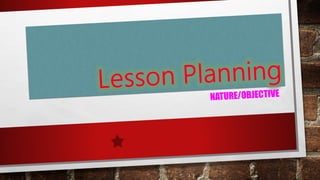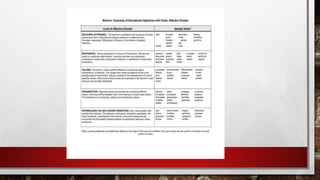Lesson planning
- 2. BASIC CONCEPTS IN WRITING EDUCATIONAL OBJECTIVES The following should be considered in writing lesson plans: 1. Who are to perform? (E.G., The students) 2. Actual behaviour to be performed is normally found in keywords like “discuss,” “identity,” “distinguish,” “develop,” “illustrate,” and “perform.” 3. What performances should be evaluated? ( e.g., essay and poetry writing, and critical analysis of a story) 4. What are the conditions under which the behavior is to be performed? (e.g., a 1 – hour exam, an oral exam, or a recitation for 30 minutes) 5. What is the standard for evaluating the success or the achievement of an evaluative objective? ( e.g., 90% of the class got at least 9 correct answers out of 10 questions.)
- 3. Sample Format Of A Lesson Plan Date:_________________ Subject/Grade Level: ______________ Behavioral Objectives: Cognitive: _______________________________________________________ Psychomotor: ____________________________________________________ Affective: _______________________________________________________ Learning Resources (e.g., books, references, page numbers) ___________________ Subject Matter _______________________________________________________ Motivation (e.g., singing, dancing, question and answer, or writing lyrics of song) __________________________________________________________________
- 4. Format A Lesson Plan Strategy can be in the form of a lecture, group discussion, film showing, or computer-aided instruction. Boardwork, exercises, and group activities must be written explicitly in the lesson plan. The generalization must be done by learners based on logical questions of the teacher. Meanwhile, the evaluation must be formative based on the lesson for the day.
- 5. Keywords In Bloom’s Taxonomy Of Educational Objectives
- 7. Psychomotor domain Taxonomy Classification Examples of Infinitives Reflex movements To flex, stretch, straighten, lengthen, shorten, and relax Fundamental movements To crawl, creep, slide, walk, jump, grasp, reach, support, tighten, handle, and begin to draw Perceptual Activities To catch, bounce, eat, write, balance, bend, draw from memory, distinguish by touching, and explore Physical activities To endure, improve, increase, stop and start, move precisely, and touch Skilled movements (complex response) To waltz, type, play the piano, skate, juggle, paint, dive, and play golf Non-discursive communication (organization) To gesture, stand, sit gracefully, dance, perform, play, paint, and design skilfully Origination To create new movements for a dance






